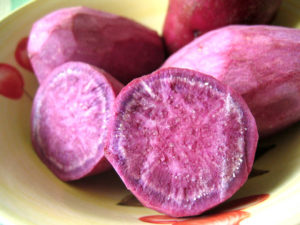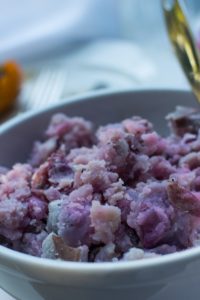How to Cook Purple Sweet Potatoes?

So you’re walking in the grocery store, and a purple tuber catches your sight. It looks like sweet potato but is of purple color. Well, it is a kind of sweet potato, commonly called the purple sweet potato. Now, you’re probably buzzing with questions like how do purple potatoes do or how to cook purple sweet potatoes?
All your purple sweet potato queries answers lie ahead. This kind of sweet potato looks very aesthetically pleasing, but to get the best of it, you should know how to cook them the right way. Every kind of potato and sweet potato has its own texture and taste, which essentially dictates how it should be cooked.
But first, let’s answer some important questions!
What are Purple Sweet Potatoes?
Purple sweet potatoes are a type of sweet potato that get their name from their vivid purple skin and flesh. This variety of sweet potatoes is not as common as other sweet potatoes or potatoes, in general.
The color purple comes from an antioxidant these potatoes contain: anthocyanin. It’s this antioxidant that gives red cabbage and red wine their distinct dark color. However, purple sweet potatoes don’t have a very dark purple color.

There are several types of sweet potatoes, which may differ in look, size, and taste. These types are usually defined by where the potatoes come from. For instance, the famous Stokes Purple® sweet potatoes come from California, but they originated from Stokes County in North Carolina.
Similarly, Okinawan sweet potatoes come from the Japanese island by the same name. However, they originated in the Americas.
So what do sweet potatoes taste like? Well, the taste varies by the type of purple of sweet potato/ But, in general, the taste is similar to that of wine with very subtle sweetness.
What are the Health Benefits of Purple Sweet Potatoes?
There are various health benefits of eating purple sweet potatoes:
- Antioxidants: As we already discussed, purple sweet potatoes are rich in antioxidants, including anthocyanin. They contain thrice the level of anthocyanin in blueberries. This antioxidant has anti-inflammatory properties. Another antioxidant it’s rich in is beta carotene.
- Source of Fiber: Yes, sweet potatoes, including the purple sweet potatoes, contain a decent amount of fiber, especially if you eat them with the skin, where most fiber is concentrated.
- Vitamin C: Purple sweet potatoes are rich in Vitamin C, the vitamin that can do wonders for your skin.
- Low GI: Unlike potatoes, purple sweet potatoes have a low glycemic index (GI), which makes them safe for diabetic consumption.
Why is My Purple Sweet Potato White Inside?
The white on the inside is usually because of the scratch in these purple sweet potatoes. This type of sweet potato usually has more starch, which makes the inside of the tuber appear white.

Then there’s also the difference of variety. If you’re using a sweet potato that has purplish skin but a white interior, you’re actually using red sweet potatoes, which is a similar yet different variety than purple sweet potatoes.
The white parts of the potato shouldn’t be mistaken as a sign of them going bad, as that white is mainly due to scratch, which is a kind of sugar (polysaccharide).
Where Can I Buy Purple Sweet Potatoes?
Availability, both in terms of markets and seasons, of purple sweet potatoes varies by variety. For instance, the Stokes Purple® sweet potatoes are available for the most part of the year in major supermarkets as well.

Similarly, Okinawan sweet potatoes are easily available online and in supermarkets and specialty vegan stores. These are available all year.
However, not all varieties are that easily available. You’ll have a hard time finding the Mokolai sweet potatoes from Hawaii in the continental US.
If you cannot find any variety of purple sweet potatoes in a supermarket, try looking for them at a farmer’s market or an Asian grocer.
Do You Have to Peel Purple Sweet Potatoes?
Whether you should peel your purple sweet potatoes depends on what you’re cooking or how you’re cooking the potatoes. If you’re boiling these sweet potatoes, you don’t necessarily need to peel them off. However, leaving the peel on will require a longer boiling time.
If you’re making a purple sweet potato mash, you should obviously peel them before or after boiling.
However, if you’re roasting these sweet potatoes or making fries out of them, it’s up to you whether you want peels off or on. Leaving the peels on for roasted potatoes can ensure you get all the fiber of these potatoes.
How Do I Make Roasted Sweet Potatoes?

I like to keep things simple whenever roasting or stir-frying veggies, so I take the same approach with my sweet potatoes, including purple sweet potatoes.
You’ll need to preheat the oven to 425 degrees. This variety of sweet potatoes is usually drier, so they may need a higher temperature and more cook time.
While the oven heats, chop the potatoes into bite-sized pieces. I usually leave the skin on, but you can peel it off if you like. (The skin does add a nice texture to the roasted sweet potatoes)
Line the baking tray with parchment paper and spread the potatoes–season with salt and a little bit of olive oil (optional). Toss them around the cover with seasoning or oil.
Now, bake for 15 minutes. Take the tray out and toss them around. Put the tray back in and bake for another 10 minutes.
You can season with more salt later if you think it needs a dash more. I love to garnish my purple sweet potatoes with some herbs, like parsley or cilantro. That’s completely optional!
Wrap Up
Now that you know how to cook purple sweet potatoes, you can make them a sideline for your dishes. These potatoes look quite appealing because of their vibrant purple hue. Plus, they have some worthy health benefits as well.
If you’re lucky enough to have these easily available near you, make sure to include them in your diet. Roasting or air frying them with the peels on is the best way to eat them!











